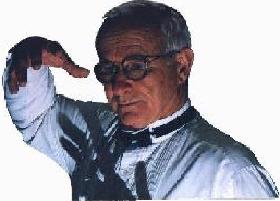Some people believe God to be the first hypnotist: He put Adam to sleep and took out a rib to make Eve.
The term "mesmerize” came into being because of Franz Anton Mesmer, (Franciscus Antonius Mesmer) who was born in On 23 May, 1734, at Iznang, in the parish of Weiler, in the bailiwick of Rudolfzell, on Lake Constance in Germany
Mesmer believed that interrupted or lost equilibrium could be corrected by moving magnets over the body. He called his theory “animal magnetism.” Later, he believed that his hands contained the same powers as steel magnets. He did not, however, give up magnets completely. One of his treatments involved a large oak tub filled with magnetized water and iron shavings. Many iron bars poked out of the tub, each one grasped by a different patient. Mesmer's treatments were popular (using the tub or‘‘baquet’’he could treat many patients simultaneously) and sometimes successful.
Mesmer spent most of his adult life in France and enjoyed, for a time, the support of Marie Antoinette. Most other physicians considered him a quack. He made a fair amount of money, and by nearly all accounts he was sincere. He treated the poor for free. The medical establishment abhorred his theories and was determined to take him down. And it did, officially, with committees, experiments, and reports by eminent doctors who dismissed his claims. All but one, a Dr. D’’Eslon, a respected court physician. He believed in the phenomenon of animal magnetism but did not believe it had anything to do with magnets. Dr. D’’Eslon believed it worked (sometimes) via the imagination of the patient, by what we would now call suggestion or hypnosis. Mesmer was adamant that his treatments had nothing to do with the imagination.
Undeterred, Mesmer continued his work, he moved out of Paris. Most of the money he made he put back into promoting his theories. Eventually, 20 hospitals, called Societies of Harmony, were built in major cities all over France.
The king of Prussia asked Mesmer to settle in Berlin. He declined, so the King sent the famous physician Wolfart to study under Mesmer. Upon returning, Wolfart was appointed Professor of Mesmerism in the Academy of Berlin and placed in charge of a magnetic hospital of 300 beds.
Mesmer died at night on March 5th, 1815. . Little did he know that one day he would be considered the father of hypnotism.
In 1815 a wandering Portuguese monk (Abbe Faria) came to Paris. He had learned in India and the Far East how to produce a somnambulistic trance by simply gazing steadily at the patient and then suddenly shouting “Sleep” (sound familiar ? ) Later, after being discredited personally, he proclaimed that the cause of the trance came within the patient and was not due to any magnetic influence of the operator.
In 1837 the Baron du Potet visited London and enlisted the interest of Dr. John Elliotson by describing his cases of painless surgery under the influence of mesmerism. John Elliotson was one of the most brilliant men in the history of English medicine. He was quick to realize the importance of this new method of treatment and began to experiment, and he was soon able to prove its value in the treatment of nervous disorders as well as its use as an anaesthetic. As had been the experience of others before him, Elliotson aroused the envy and jealousy of the medical profession.
In India, Dr. James Esdaile began to experiment with mesmerism after reading Elliotson’s work. In 1845 he succeeded with his first case and in 1846 was placed in charge of a special hospital in Calcutta. Here Esdaile performed several thousand minor and about three hundred major surgical operations with mesmerism, and he was able to reduce the death rate from 50 % to 5% by the use of his methods.
A Swiss magnetizer, LaF\fontaine, while touring England giving exhibitions was noticed by Dr. James Braid. In 1841 Braid attended a public performance with the intention of exposing Lafontaine as a charlatan. Like many others, he was astounded to find that the phenomena of trance was real. Braid later coined the word “hypnotism” to describe the art or science of inducing “hypnosis.” In 1843 Braid published a book called “Neurypnology, of the Rationale of Nervous Sleep” in which he described his method and the cure of cases such as rheumatism, epilepsy, paralysis and neuralgia.
Harvey Hunt

Qualifications / experience
--- Certified by and a member of NGH (National Guild of Hypnotists)
--- Certified by The Nat'l Board of Professional & Ethical Standards Hypnosis Education & Certification --- Practicing Hypnotherapist.
--- Entertaining with Hypnosis stage shows.
--- Presenting lectures aboard cruise ships, to Corporations and service clubs.
--- Motivational Lectures for Corporate events.
 |
Stage Shows ..... Jovan is available to do a Hypnosis show for your special event or company party. Call for prices and availability. 805 / 434-2171 |
Contact the Hypnotist
mailto:jovan@americanserviceco.com
Tel.
805 / 434-2171
Copyrighted 2006
American
Service Company
All Rights
Reserved